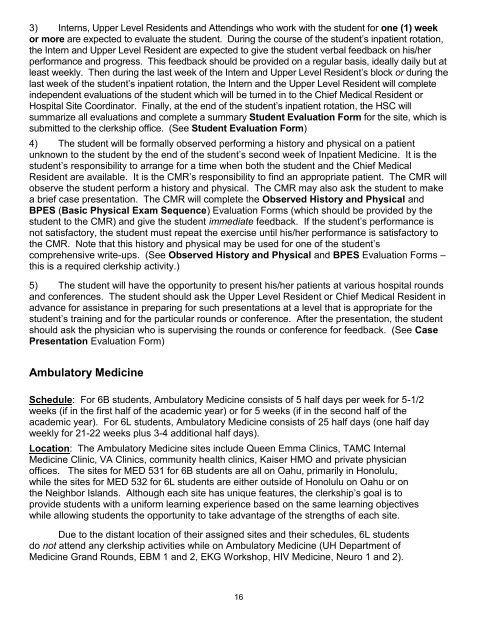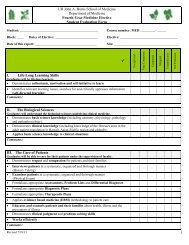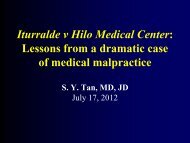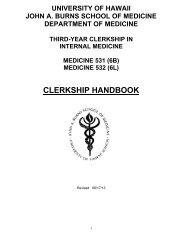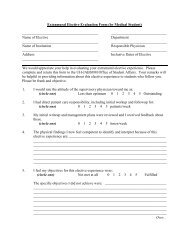clerkship handbook - University of Hawaii â Department of Medicine
clerkship handbook - University of Hawaii â Department of Medicine
clerkship handbook - University of Hawaii â Department of Medicine
You also want an ePaper? Increase the reach of your titles
YUMPU automatically turns print PDFs into web optimized ePapers that Google loves.
3) Interns, Upper Level Residents and Attendings who work with the student for one (1) week<br />
or more are expected to evaluate the student. During the course <strong>of</strong> the student’s inpatient rotation,<br />
the Intern and Upper Level Resident are expected to give the student verbal feedback on his/her<br />
performance and progress. This feedback should be provided on a regular basis, ideally daily but at<br />
least weekly. Then during the last week <strong>of</strong> the Intern and Upper Level Resident’s block or during the<br />
last week <strong>of</strong> the student’s inpatient rotation, the Intern and the Upper Level Resident will complete<br />
independent evaluations <strong>of</strong> the student which will be turned in to the Chief Medical Resident or<br />
Hospital Site Coordinator. Finally, at the end <strong>of</strong> the student’s inpatient rotation, the HSC will<br />
summarize all evaluations and complete a summary Student Evaluation Form for the site, which is<br />
submitted to the <strong>clerkship</strong> <strong>of</strong>fice. (See Student Evaluation Form)<br />
4) The student will be formally observed performing a history and physical on a patient<br />
unknown to the student by the end <strong>of</strong> the student’s second week <strong>of</strong> Inpatient <strong>Medicine</strong>. It is the<br />
student’s responsibility to arrange for a time when both the student and the Chief Medical<br />
Resident are available. It is the CMR’s responsibility to find an appropriate patient. The CMR will<br />
observe the student perform a history and physical. The CMR may also ask the student to make<br />
a brief case presentation. The CMR will complete the Observed History and Physical and<br />
BPES (Basic Physical Exam Sequence) Evaluation Forms (which should be provided by the<br />
student to the CMR) and give the student immediate feedback. If the student’s performance is<br />
not satisfactory, the student must repeat the exercise until his/her performance is satisfactory to<br />
the CMR. Note that this history and physical may be used for one <strong>of</strong> the student’s<br />
comprehensive write-ups. (See Observed History and Physical and BPES Evaluation Forms –<br />
this is a required <strong>clerkship</strong> activity.)<br />
5) The student will have the opportunity to present his/her patients at various hospital rounds<br />
and conferences. The student should ask the Upper Level Resident or Chief Medical Resident in<br />
advance for assistance in preparing for such presentations at a level that is appropriate for the<br />
student’s training and for the particular rounds or conference. After the presentation, the student<br />
should ask the physician who is supervising the rounds or conference for feedback. (See Case<br />
Presentation Evaluation Form)<br />
Ambulatory <strong>Medicine</strong><br />
Schedule: For 6B students, Ambulatory <strong>Medicine</strong> consists <strong>of</strong> 5 half days per week for 5-1/2<br />
weeks (if in the first half <strong>of</strong> the academic year) or for 5 weeks (if in the second half <strong>of</strong> the<br />
academic year). For 6L students, Ambulatory <strong>Medicine</strong> consists <strong>of</strong> 25 half days (one half day<br />
weekly for 21-22 weeks plus 3-4 additional half days).<br />
Location: The Ambulatory <strong>Medicine</strong> sites include Queen Emma Clinics, TAMC Internal<br />
<strong>Medicine</strong> Clinic, VA Clinics, community health clinics, Kaiser HMO and private physician<br />
<strong>of</strong>fices. The sites for MED 531 for 6B students are all on Oahu, primarily in Honolulu,<br />
while the sites for MED 532 for 6L students are either outside <strong>of</strong> Honolulu on Oahu or on<br />
the Neighbor Islands. Although each site has unique features, the <strong>clerkship</strong>’s goal is to<br />
provide students with a uniform learning experience based on the same learning objectives<br />
while allowing students the opportunity to take advantage <strong>of</strong> the strengths <strong>of</strong> each site.<br />
Due to the distant location <strong>of</strong> their assigned sites and their schedules, 6L students<br />
do not attend any <strong>clerkship</strong> activities while on Ambulatory <strong>Medicine</strong> (UH <strong>Department</strong> <strong>of</strong><br />
<strong>Medicine</strong> Grand Rounds, EBM 1 and 2, EKG Workshop, HIV <strong>Medicine</strong>, Neuro 1 and 2).<br />
16


